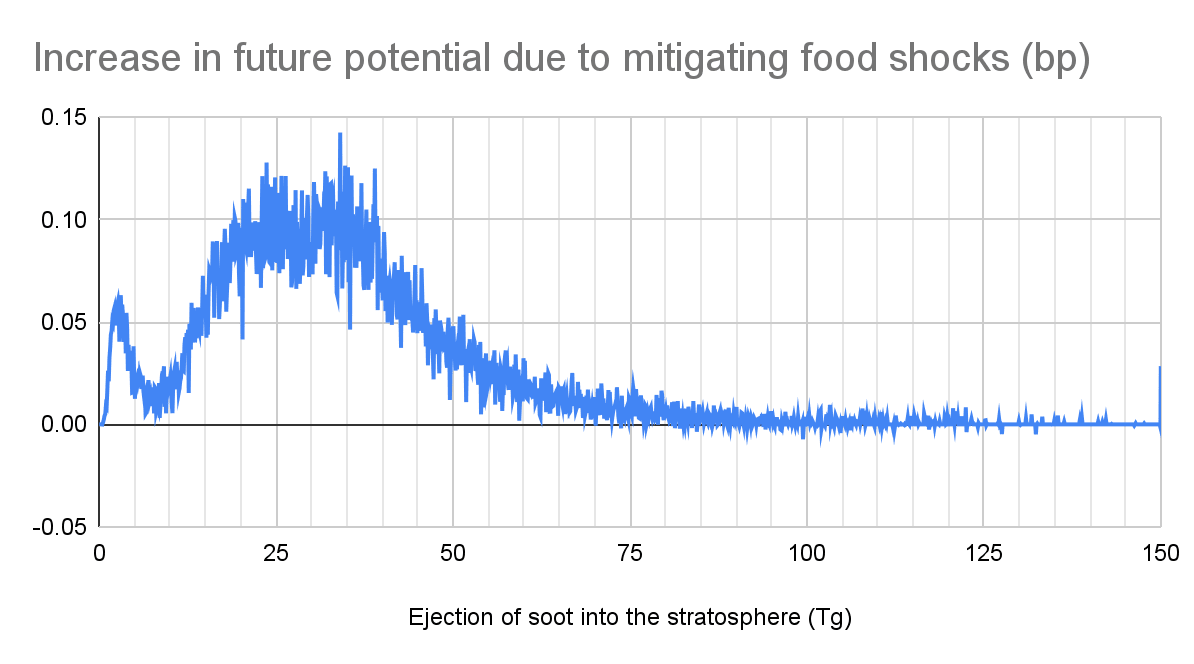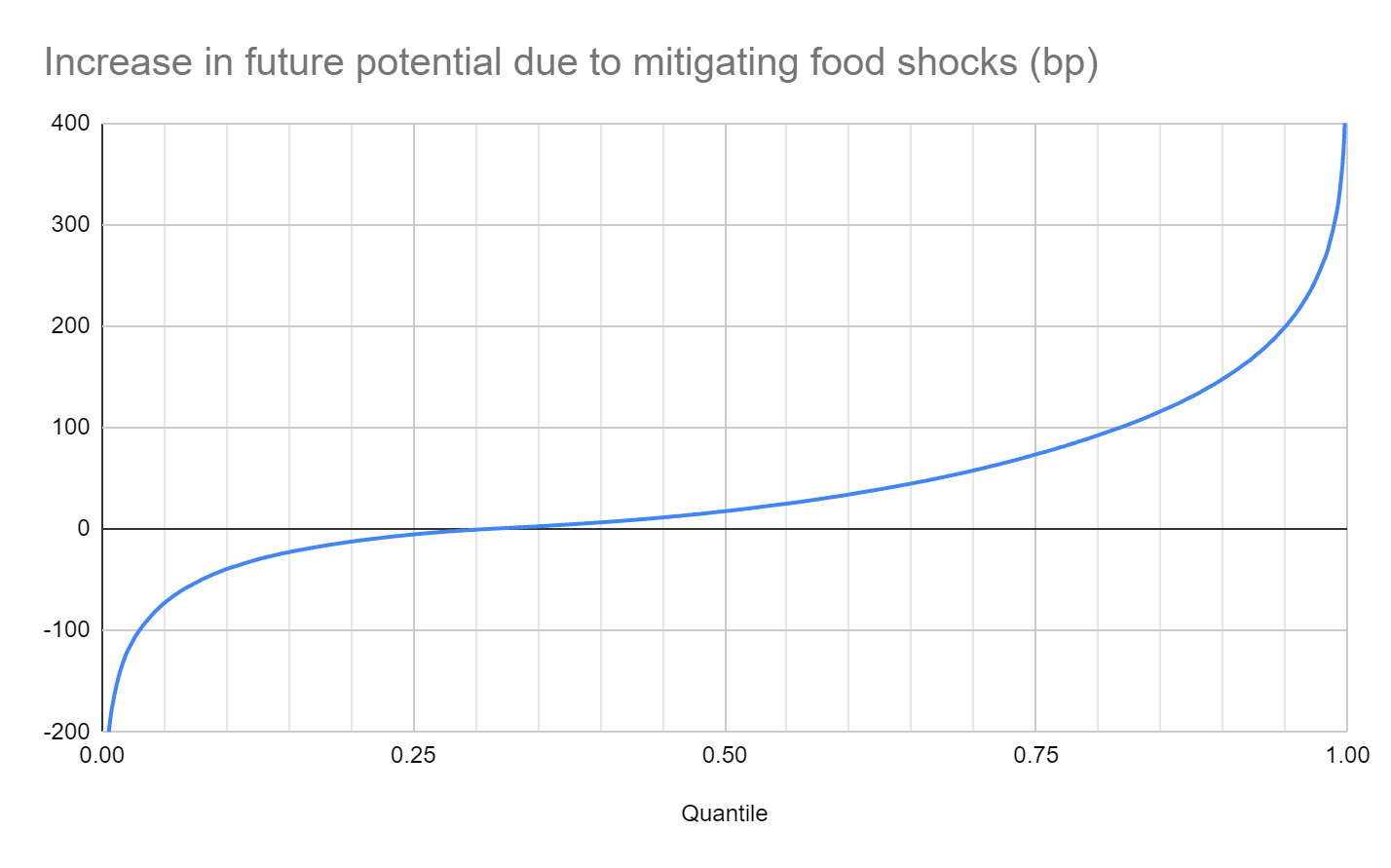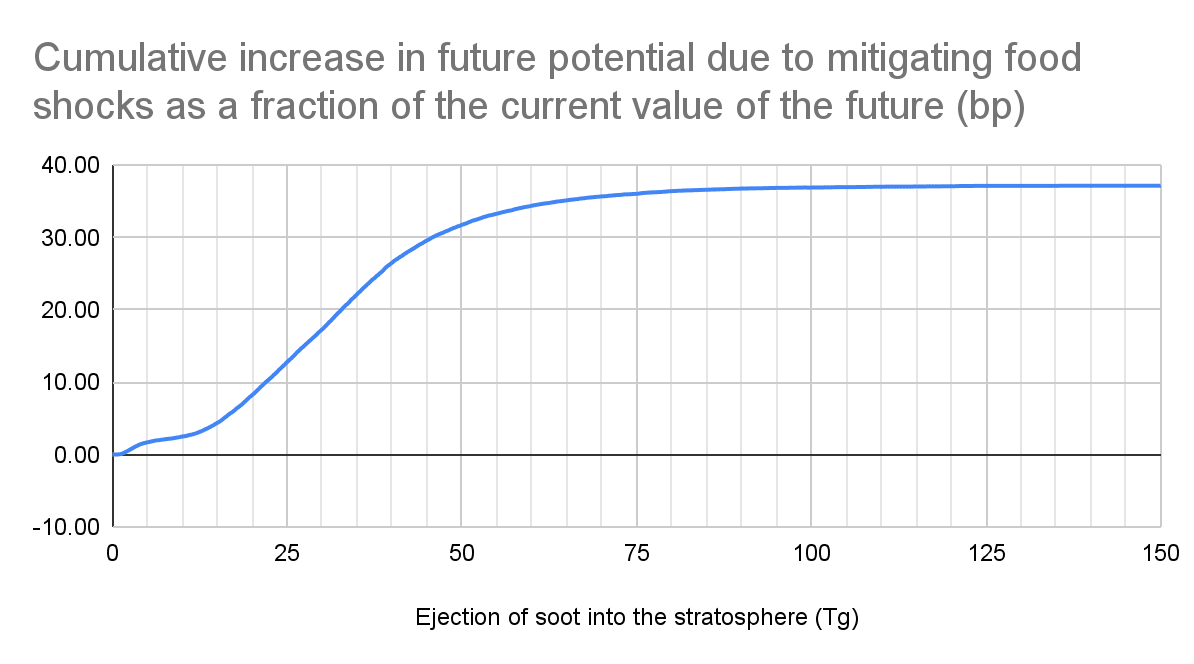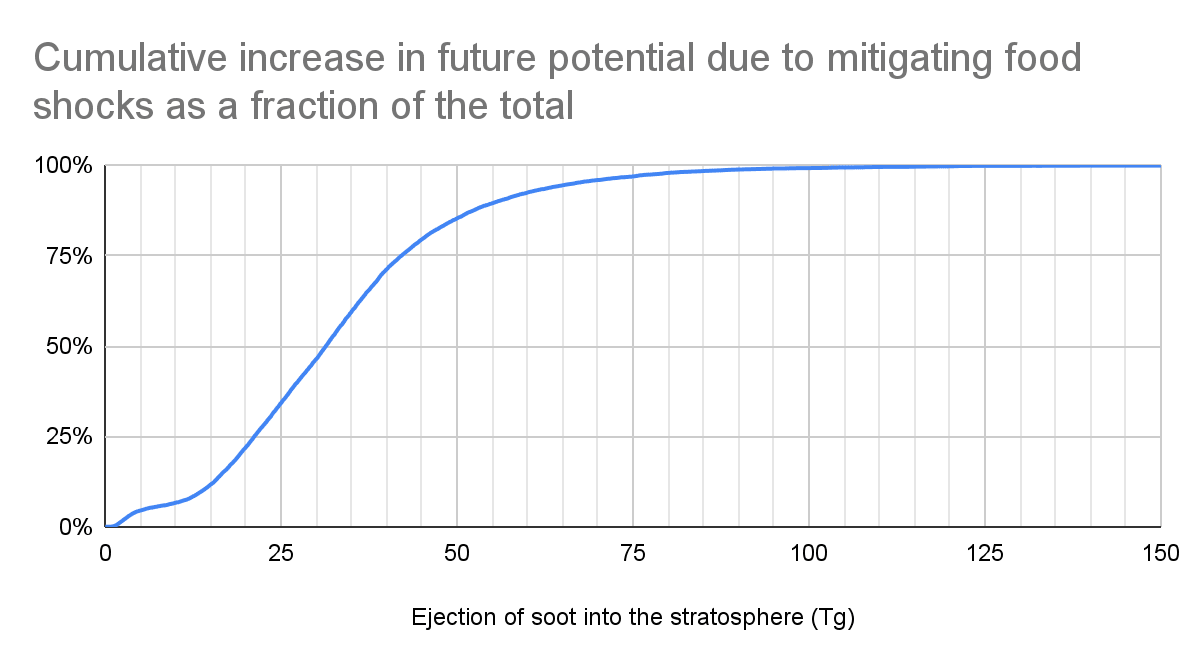Increase in future potential due to mitigating food shocks caused by abrupt sunlight reduction scenarios
By Vasco Grilo🔸 @ 2023-03-28T07:43 (+12)
Disclaimer: this is not a project from Alliance to Feed the Earth in Disasters (ALLFED).
Summary
- I estimate globally (and fully) mitigating food shocks caused by abrupt sunlight reduction scenarios (ASRSs) between 2024 and 2100 leads to an increase in future potential[1] of 37.2 bp (5th to 95th percentile, -73.1 to 199).
- The increase in future potential due to nationally (and fully) mitigating food shocks varies greatly across countries. It is:
- For the United States, the country whose national mitigation leads to the largest increase in future potential, 1.21 times that of global mitigation.
- For China, the country whose national mitigation leads to the largest decrease in future potential, -1.21 times that of global mitigation.
- All results should be taken with a big grain of salt, as they rely on quite speculative assumptions.
Acknowledgements
Thanks to Anonymous Person.
Introduction
ASRSs involve a significant reduction in the amount of sunlight reaching the Earth’s surface. This causes temperatures to drop, so agricultural yields decrease, and so does food supply. ASRSs can be a nuclear winter, volcanic winter, or impact winter.
I estimated here the increase in future potential due to globally (and fully) or nationally (and fully) mitigating food shocks caused by ASRSs conditional on them happening. The present analysis leverages these results, and weights them by the likelihood of the various levels of severity of ASRSs. The output can be interpreted as estimates for the importance/scale of the problem resilient food solutions are trying to solve.
I encourage you to check the methods of my previous analysis, which include quite speculative assumptions, to see how much to trust the results I get here. However, I believe one should also have in mind the output of that analysis, i.e. the badness of ASRSs by level of severity, is not supposed to be very resilient. It is only meant to be an improvement on the direct guesses of that factor provided in Denkenberger 2022 (whose evaluation by The Unjournal is here), and this post from Marie Buhl.
If not accuracy, I hope my explicit modelling at least increases reasoning transparency, and therefore enables criticism to be more constructive.
Methods
I estimated the increase in future potential due to mitigating food shocks caused by ASRSs from the sum of those linked to nuclear war and volcanic eruptions. In comparison to these, the risk from asteroids and comets is negligible. Based on Toby Ord’s best guesses given in Table 6.1 of The Precipice, the existential risk between 2021 and 2120 from asteroids and comets is 1 % (= 10^-4/0.01) that from supervolcanoes, and 0.1 % (= 10^-4/0.1) that from nuclear war.
The data and calculations are in this Sheet (see tab “TOC”) and this Colab. I modelled all variables as independent distributions, and ran a Monte Carlo simulation with 100 k samples per variable to get the results[3].
Nuclear war
I estimated the increase in future potential due to mitigating food shocks caused by ASRSs linked to nuclear war between 2024 and 2100 from the product between:
- Probability of global nuclear war between 2024 to 2100. I set this to 17.5 %[4] (= 1 - (1 - 11 %)^((2100 - 2024 + 1)/(2070 - 2023.25))) in agreement with Metaculus’ community prediction of 11 % (on 27 March 2023) for the chance of global thermonuclear war before 2070.
- The respective Metaculus’ question belongs to the categories of armed conflict, impactful forecasting prize, effective altruism, and weapons.
- The Brier score of Metaculus’ community predictions evaluated at all times for the questions of at least one of the above categories was 0.091 on 27 March 2023 (see here).
- Increase in future potential due to mitigating food shocks caused by ASRSs if there is a nuclear war between The North Atlantic Treaty Organization (NATO) and Russia from 2024 to 2100. I set this to a distribution whose:
- Input is an ejection of soot into the stratosphere, which I obtained from the product between:
- Ejection of soot into the stratosphere if there is a nuclear war between NATO and Russia. I defined this as a lognormal distribution with 5th and 95th percentiles equal to 14 and 66 Tg[5], which are the lower and upper bound of the 95 % confidence interval calculated here by Luisa Rodriguez.
- Adjustment factor to model the change in the number of (non-retired) nuclear warheads[6]. I set this to the ratio between:
- The mean number of nuclear warheads globally from 2024 to 2100. I computed this from normal distributions whose 25th and 75th percentiles are given by Metaculus’ community predictions for 2023, 2025, 2032, 2052, and 2122 (on 26 March 2023), assuming the number of nuclear warheads evolves linearly between each consecutive pair of these years.
- The number of nuclear warheads from NATO and Russia in 2019, when Luisa published this, which was 8,640[7] according to these data from OWID.
- Input is an ejection of soot into the stratosphere, which I obtained from the product between:
- Quantile function is obtained by linearly interpolating between[8]:
- For 5 to 150 Tg, those I got here for 5, 16, 27, 37, 47 and 150 Tg. For example, the quantile function for global mitigation for a soot ejection of 32 Tg would be the mean between those for 27 and 37 Tg shown in the graph here.
- For less than 5 Tg, zero[9] and those I got here for 5 Tg.
- For more than 150 Tg, those I got here for 150 Tg, and 1 for 15 Pg. This is the amount of soot linked to the impact winter of the Cretaceous–Paleogene extinction event, and would lead to a 100 % food shock. According to the simulations of Bardeen 2017, “as a result [of an ASRS of 15 Pg], little or no sunlight reaches the surface for over a year, such that photosynthesis is impossible and continents and oceans cool by as much as 28 °C and 11 °C, respectively”.
Volcanic eruptions
I estimated the increase in future potential due to mitigating food shocks caused by ASRSs linked to volcanic eruptions between 2024 and 2100 from the product between:
- Probability of a volcanic eruption with a volcanic explosivity index (VEI) of at least 7 between 2024 and 2100, which I set to 1/6 in line with Cassidy 2022.
- Increase in future potential due to mitigating food shocks caused by ASRSs if such volcanic eruption happens. I determined this as in the previous section, but used an ejection of soot into the stratosphere 10 % as large, because:
- Based on Toby Ord’s best guesses given in Table 6.1 of The Precipice, the existential risk between 2021 and 2120 from supervolcanic eruptions is 10 % (= 10^-4/0.001) that from nuclear war.
- From the 2nd table here, the increase in future potential from globally mitigating food shocks increases roughly linearly with the soot ejected into the stratosphere (coefficient of determination of 92.1 %).
- A volcanic eruption with a VEI of a least 7 is roughly as likely as global nuclear war (1/6 = 16.7 % is close to 17.5 %).
Results
The key results are in the tables below. The full results are in the Sheet.
Key stats
Where the food shocks are mitigated | Increase in future potential due to mitigating food shocks caused by ASRSs as a fraction of the current value of the future (bp) | ||
|---|---|---|---|
Mean | 5th percentile | 95th percentile | |
World | 37.2 | -73.1 | 199 |
Mean country | 0.919 | -4.29 | 8.03 |
Best country | 45.2 | -66.6 | 214 |
10th best country | 4.14 | -5.64 | 21.9 |
10th worst country | -0.976 | -4.59 | 1.50 |
Worst country | -44.9 | -178 | 66.4 |
Global mitigation

National mitigation
Countries where the food shocks are mitigated by descending order of increase in future potential | Increase in future potential due to mitigating food shocks caused by ASRSs as a fraction of the current value of the future (bp) | |||
|---|---|---|---|---|
Ranking | Country | Mean | 5th percentile | 95th percentile |
1 | United States | 45.2 | -66.6 | 214 |
2 | Japan | 20.3 | -29.9 | 95.9 |
3 | Germany | 19.1 | -29.9 | 99.5 |
4 | United Kingdom | 12.9 | -21.4 | 68.9 |
5 | France | 10.3 | -15.0 | 59.1 |
6 | Canada | 9.58 | -13.2 | 42.4 |
7 | South Korea | 9.28 | -13.9 | 44.2 |
8 | Italy | 8.07 | -12.3 | 46.8 |
9 | Netherlands | 5.01 | -7.74 | 26.5 |
10 | Poland | 4.14 | -5.64 | 21.9 |
136 | Kazakhstan | -0.976 | -4.59 | 1.50 |
137 | United Arab Emirates | -1.09 | -4.41 | 1.52 |
138 | Pakistan | -1.33 | -7.70 | 1.88 |
139 | Saudi Arabia | -1.33 | -9.26 | 1.55 |
140 | Turkey | -1.43 | -7.82 | 1.90 |
141 | India | -1.78 | -9.07 | 2.86 |
142 | Vietnam | -1.78 | -11.0 | 2.70 |
143 | Iran | -3.52 | -18.8 | 5.37 |
144 | Russian | -5.42 | -23.4 | 9.24 |
145 | China | -44.9 | -178 | 66.4 |
Discussion
Global mitigation
According to my results, globally mitigating food shocks caused by ASRSs between 2024 and 2100 leads to an increase in future potential of 37.2 bp (5th to 95th percentile, -73.1 to 199). This is 4.83 (-9.50 to 25.9) times Toby Ord’s best guess of 7.70 bp (= 1 - (1 - 0.1 %)^(77/100)) for the existential risk from nuclear war for the same period assuming constant annual risk. Nevertheless, it is unclear whether my estimate is directly comparable to Toby Ord’s guess:
- Mine refers to a change in value of the future.
- Toby Ord’s refers to the chance of an existential catastrophe, which is defined in The Precipice as “the destruction of humanity’s longterm potential”.
If the value of the future were binary, a change in it would be directly proportional to the probability of an existential catastrophe, in which case my estimate would be directly comparable to Toby Ord’s guess.
I find mitigating food shocks has both positive and negative heavy tails, as is illustrated in the 1st graph for the case of global mitigation[11]. This is essentially because, in my model, I assume a 25 % chance the future would be worse for higher socioeconomic indices (details here).
Arguments for the existence of a counterproductive heavy tail are described in Kokotajlo 2020 (whose EA Forum crosspost is here):
We canvass arguments EAs have given for the existence of a positive (or “right”) heavy tail and argue that they can also apply in support of a negative (or “left”) heavy tail where counterproductive interventions do orders of magnitude more harm than ineffective or moderately harmful ones.
The 2nd and 3rd graphs show the increase in future potential due to globally mitigating food shocks is not driven by very severe ASRSs[12]. 5 %, 50 % and 95 % of the increase come from ASRSs whose soot ejection into the stratosphere is smaller than 5.90, 31.4 and 66.7 Tg. Larger soot ejections lead to greater drops in food production, but they are rare, so their expected harm ends up playing a minor role in my model.
National mitigation
The increase in future potential due to nationally mitigating food shocks varies greatly across countries. It is:
- For the United States, the country whose national mitigation leads to the largest increase in future potential:
- 49.2 (= 45.2/0.919) times that of a randomly selected country (the mean country).
- 10.9 (= 45.2/4.14) times that of the 10th country (Poland).
- 1.21 (= 45.2/37.2) times that of global mitigation.
- For China, the country whose national mitigation leads to the largest decrease in future potential:
- -48.8 (= -44.9/0.919) times that of a randomly selected country (the mean country).
- 46.0 (= 44.9/0.976) times that of the 10th worst country (Kazakhstan).
- -1.21 (= -44.9/37.2) times that of global mitigation.
These estimates illustrate the presence of both left and right tails. Furthermore, nationally mitigating food shocks is harmful not only in pessimistic cases, but also in expectation in 40.7 % (= 59/145) of the countries I analysed. The reasons are (see discussion here):
- I suppose (see here) real gross domestic product (real GDP) is a good proxy for (good or bad) influence in the future.
- Mitigating the food shocks of a country counterfactually increases its real GDP in the worst year of the ASRS.
- Consequently, mitigating the food shocks of a country with low[13] socioeconomic indices[14] leads to lower global socioeconomic indices weighted by influence. I assume this is bad, although with significant uncertainty (see 2nd paragraph of the previous section).
Is it possible that nationally mitigating food shocks robustly increases real GDP in the nearterm, but accidentally leads to a worse future if it decreases global socioeconomic indices weighted by influence? Is this even a real trade-off? Would it be better to use socioeconomic indices multiplied, instead of weighted, by real GDP as a proxy for future potential, such that greater real GDP would always be good? I am uncertain about the answers.
Cost-effectiveness
The cost-effectiveness of an intervention to mitigate food shocks can be obtained from the ratio between the increase in future potential it causes, and its cost. The former can be calculated by inputting a relative increase in food supply in this model, and then running the present analysis with the updated quantile functions for the increase in future potential by ejection of soot into the stratosphere.
Here I got a (marginal) cost-effectiveness of 3.95 bp/G$ for the area of longtermism and catastrophic risk prevention. To meet that bar, an intervention costing 10 M$ would have to cause an increase in future potential equal to 0.106 % (= 3.95*0.01/37.2) of that of global full mitigation.
The (longterm) cost-effectiveness of resilient food solutions is estimated in Denkenberger 2022 (whose evaluation by The Unjournal is here), and this post from Marie Buhl. I may estimate it too in the future.
- ^
Value of the future, which I think about as expected total hedonistic utility.
- ^
1 Tg corresponds to 1 Mt.
- ^
For me, the running time is 7 min.
- ^
This corresponds to an annual probability of 0.249 % (= 1 - (1 - 0.175)^(1/(2100 - 2024 + 1))).
- ^
The mean of this distribution is 33.4 Tg, which is 1.13 (= 33.4/30) times that of Luisa.
- ^
The mean of this adjustment factor is 84.4 %.
- ^
3,805 from the United States, 4,330 from Russia, 300 from France, and 205 from the United Kingdom.
- ^
I approximated each quantile function by 1001 points corresponding to the quantiles 0, 0.001, 0.002, …, 0.999 and 1.
- ^
Because there should be no change in the potential of the future if there is no soot ejected into the stratosphere.
- ^
Except for the point of 150 Tg, which goes from 150 to 15 k Tg, such that there is a bump at the end of the line.
- ^
The graphs for national mitigation can be obtained in tab “Increase in future potential - quantile functions”, selecting the desired country in the dropdown menu of A4.
- ^
The graphs for national mitigation can be obtained in tab “Increase in future potential by soot - PDFs and CDFs”, selecting the desired country in the dropdown menu of A2.
- ^
Relative to the mean across countries weighted by real gross domestic product.
- ^
As a first approximation, low Varieties of Democracy’s main index (see table here).
Stan Pinsent @ 2023-03-28T11:49 (+8)
My attempt to summarize why the model predicts that preventing famine in China and other countries will have a negative effect on the future:
- Much of the value of the future hinges on whether values become predominantly democratic or antidemocratic
- The more prevalent antidemocratic values (or populations) are after a global disaster, the likelier it is that such values will become predominant
- Hence preventing deaths in antidemocratic countries can have a negative effect on the future.
Or as the author puts it in a discussion linked above:
To be blunt for the sake of transparency, in this model, the future would improve if the real GDP of China, Egypt, India, Iran, and Russia dropped to 0, as long as that did not significantly affect the level of democracy and real GDP of democratic countries. However, null real GDP would imply widespread starvation, which is obviously pretty bad! I am confused about this, because I also believe worse values are associated with a worse future. For example, they arguably lead to higher chances of global totalitarianism or great power war.
I agree with the author that the conclusion is confusing. Even concerning.
I'd suggest that the conclusion is out-of-sync with how most people feel about saving lives in poor, undemocratic countries. We typically don't hesitate to tackle neglected tropical diseases on the basis that doing so boosts the populations of dictatorships.
Vasco Grilo @ 2023-03-28T14:16 (+2)
Thanks for the great summary, Stan!
I'd suggest that the conclusion is out-of-sync with how most people feel about saving lives in poor, undemocratic countries. We typically don't hesitate to tackle neglected tropical diseases on the basis that doing so boosts the populations of dictatorships.
I agree. At the same time, I do not think we can take the status quo for granted, because reality is often quite complex. For example, most people do not hesitate to eat factory-farmed animals, but the scale of their (negative) welfare may well outweight that of humans (see here).
This is not to say I am confident socioeconomic indices weighted by real GDP are a better proxy for longterm value than population:
Is it possible that nationally mitigating food shocks robustly increases real GDP in the nearterm, but accidentally leads to a worse future if it decreases global socioeconomic indices weighted by influence? Is this even a real trade-off? Would it be better to use socioeconomic indices multiplied, instead of weighted, by real GDP as a proxy for future potential, such that greater real GDP would always be good? I am uncertain about the answers.
However, do you think halving the population of the United States while doubling that of China would be good in the longterm (assuming constant socioeconomic indices)? I think it would be bad in expectation (although with high uncertainty) because the world would then have a major undemocratic superpower with 4 times as much GDP as the wealthiest democratic country.
I think saving lives would be more important in terms of longterm value if the population loss was higher, because then it would be reducing the chance of extinction. I think it is quite hard for a nuclear war to lead to extinction, so I preferred using socioeconomic indices to estimate future value.
We should also consider saving lives in low-income countries can affect their socioeconomic indices, which seems to be a neglected topic. From Kono 2009 (emphasis mine):
Although many people have argued that foreign aid props up dictators, few have claimed that it props up democrats, and no one has systematically examined whether either assertion is empirically true. We argue, and find, that aid has both effects. Over the long run, sustained aid flows promote autocratic survival because autocrats can stockpile this aid for use in times of crisis. Each disbursement of aid, however, has a larger impact on democratic survival because democrats have fewer alternative resources to fall back on.
In my model, mitigating the food shock of any given country counterfactually increases its real GDP per capita, and therefore socioeconomic indices.


